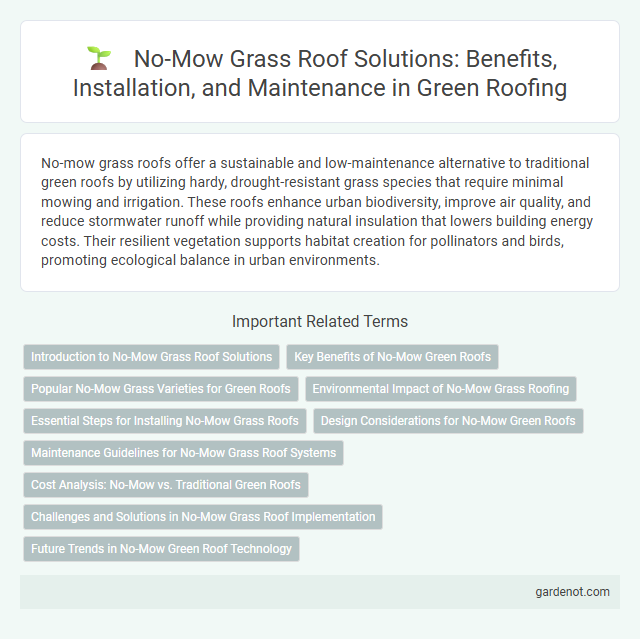No-mow grass roofs offer a sustainable and low-maintenance alternative to traditional green roofs by utilizing hardy, drought-resistant grass species that require minimal mowing and irrigation. These roofs enhance urban biodiversity, improve air quality, and reduce stormwater runoff while providing natural insulation that lowers building energy costs. Their resilient vegetation supports habitat creation for pollinators and birds, promoting ecological balance in urban environments.
Introduction to No-Mow Grass Roof Solutions
No-mow grass roofs feature low-maintenance turf varieties that require minimal or no mowing, reducing labor and maintenance costs significantly. These green roofs enhance urban biodiversity by providing habitats for pollinators and improving air quality through natural filtration processes. Utilizing drought-tolerant, native grass species helps conserve water while promoting sustainable green infrastructure in urban environments.
Key Benefits of No-Mow Green Roofs
No-mow green roofs significantly reduce maintenance time and costs by eliminating the need for regular mowing, while promoting biodiversity through diverse native plant species that support pollinators and wildlife. They enhance stormwater management by improving water retention and reducing runoff, which helps mitigate urban flooding and water pollution. Energy efficiency benefits are notable as these roofs provide superior insulation, lowering cooling and heating expenses in buildings.
Popular No-Mow Grass Varieties for Green Roofs
Popular no-mow grass varieties for green roofs include Buffalo Grass, known for its drought tolerance and low maintenance needs, and Fine Fescue, prized for its shade tolerance and low nutrient requirements. Creeping Red Fescue offers excellent erosion control and thrives in various climates, making it a favorite for sustainable green roofing. These grasses support biodiversity, reduce stormwater runoff, and enhance thermal insulation in urban environments.
Environmental Impact of No-Mow Grass Roofing
No-mow grass roofs significantly reduce carbon emissions by eliminating the need for gas-powered lawn mowers, supporting cleaner air quality. These roofs enhance urban biodiversity by providing habitats for pollinators and other beneficial insects. Water retention is improved due to deep-rooted grasses, mitigating stormwater runoff and reducing the risk of urban flooding.
Essential Steps for Installing No-Mow Grass Roofs
Installing a no-mow grass roof begins with selecting drought-tolerant, low-maintenance grass species such as fescue or buffalo grass to reduce water and mowing requirements. Proper substrate preparation involves layering a lightweight, nutrient-rich growing medium that ensures adequate drainage and root support for rooftop conditions. Incorporating efficient irrigation systems and periodic maintenance checks promotes healthy growth while minimizing upkeep on no-mow green roofs.
Design Considerations for No-Mow Green Roofs
No-mow green roofs require strategic plant selection emphasizing low-growing, drought-tolerant grasses that thrive with minimal maintenance and reduce mowing frequency. Proper substrate depth and composition are critical to support root health while ensuring adequate drainage and nutrient retention, preventing waterlogging and promoting plant resilience. Incorporating lightweight, permeable layers enhances structural integrity and facilitates rainwater absorption, optimizing the roof's ecological and thermal performance.
Maintenance Guidelines for No-Mow Grass Roof Systems
No-mow grass roof systems require minimal maintenance compared to traditional green roofs, focusing primarily on periodic watering during extended dry periods and occasional removal of invasive weeds to preserve plant health. Regular inspections ensure proper drainage and identify any pest issues early, preventing damage to the grass and underlying roof materials. Fertilization is rarely needed but can be applied sparingly with slow-release, organic fertilizers to promote sustainable growth without encouraging excessive mowing.
Cost Analysis: No-Mow vs. Traditional Green Roofs
No-mow grass roofs reduce maintenance expenses by eliminating regular mowing and trimming, leading to significant labor cost savings compared to traditional green roofs. Initial installation costs of no-mow roofs are comparable to conventional systems, but long-term operational savings enhance their cost-effectiveness. Studies indicate that no-mow green roofs lower water usage and maintenance frequency, further optimizing lifecycle expenses.
Challenges and Solutions in No-Mow Grass Roof Implementation
No-mow grass roofs face challenges such as uneven growth, invasive weeds, and limited drought resistance, which can compromise their ecological benefits and aesthetic appeal. Solutions include selecting drought-tolerant, native grass species, implementing precise irrigation systems, and employing periodic manual maintenance to control weed spread without regular mowing. Integrating sensor-based moisture monitoring and soil management practices enhances plant health, ensuring long-term sustainability of no-mow grass roofs.
Future Trends in No-Mow Green Roof Technology
No-mow grass roofs are advancing with innovations such as drought-resistant turf varieties and automated irrigation systems that optimize water use while minimizing maintenance. Emerging trends include integrating sensor technology to monitor plant health and soil moisture, enhancing sustainability and reducing the need for manual care. Future developments emphasize eco-friendly materials and modular designs that improve installation efficiency and adaptability in urban environments.
No-mow grass roof Infographic

 gardenot.com
gardenot.com